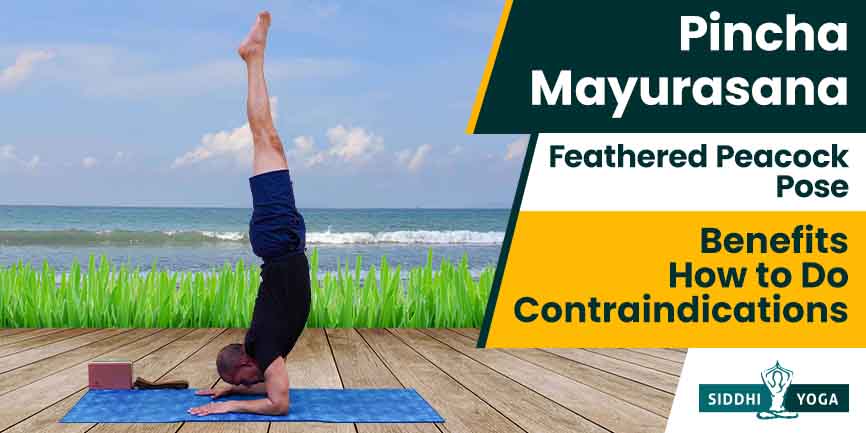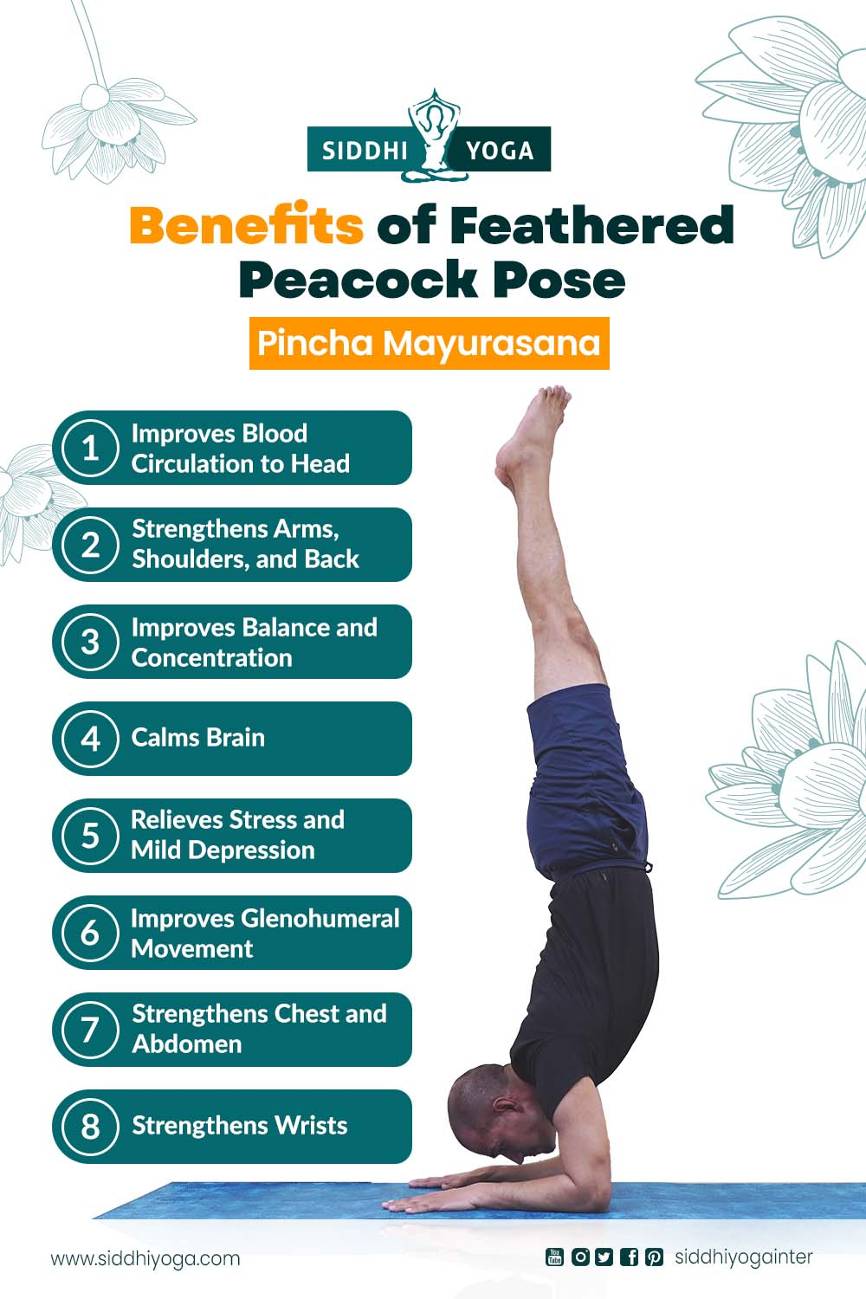
Feathered Peacock Pose
mayura: “peacock”
asana: “pose”
Introduction
Pincha Mayurasana (pin-cha my-your-AHS-anna) strengthens the shoulders, arms, core, and back. It stretches the shoulders, neck, chest, and abdomen. Circulation to the brain also increases.
This pose is tough to perform but daily practice makes it easy. To do Pincha Mayurasana, you have to first be perfect in the basic level of Ardha Pincha Mayurasana or Dolphin Pose and then go for this asana which has been named after its shape – a peacock’s feather extending up from its wings. Forearm stands provide more stability than handstands because they are wider with larger establishments.
Yoga may be an effective way for athletes to improve their balance and flexibility. The results of this study suggest as much, with yogis demonstrating improved measures in these two specific components after only 10 weeks.
Muscle Focus
Dancer Pose focuses on several muscles such as
- Back muscles
- Shoulders (Deltoid)
- Arms (Biceps and Triceps)
- Core
- Legs (Quadriceps)
- Gluteus
Ideal For Health Conditions
- Helps to develop better coordination between mind and body.
- Strengthen your back, arms, shoulders, and core.
- Improves blood circulation and stamina.
Benefits of Pincha Mayurasana or Feathered Peacock Pose

1. Improves Blood Circulation to the Head
It helps to improve overall blood circulation and also improves blood circulation to the head.
2. Strengthens Arms, Shoulders and Back
This pose helps to strengthen your hands, wrist, shoulder blades & arm’s muscle at once. It strengthens upper body muscles as well as lower body muscles too. This pose tones your abdomen area by contracting it while in this posture.
3. Improves Balance and Concentration
It is an advanced level of yoga that requires a lot of practice and patience to master it correctly; hence you need to be focused on balancing yourself for longer periods of time which will help you master both aspects i.e., balance and focus/concentration in Pincha Mayurasana or Feathered Peacock Pose.
4. Calms the Brain and Relieves Stress and Mild Depression
This asana is named after a peacock’s feather because of its resemblance. This pose helps to achieve mental stability by calming the brain. It also releases any stress or mild depression that you might be feeling.
5. Improves Glenohumeral Movement
The shoulders flex and extend, as well as move in a glenohumeral manner. In addition, the scapulothoracic joints contribute to Pincha Mayurasana. The glenohumeral joint is a ball-and-socket joint that allows for a large range of motion in the shoulder. The greater tubercle of the humerus articulates with the glenoid fossa of the scapula, and the head of the humerus articulates with the acromion process of the scapula. This type of mobility is essential for activities such as reaching overhead or behind your back. Pincha Mayurasana helps to improve this mobility by providing resistance to these movements.
6. Strengthens Chest and Abdomen as well as Wrists
Pincha Mayurasana or Feathered Peacock Pose helps to strengthen your chest and abdominal muscles. In this pose, these muscles play a major role in stabilizing the body.
Contraindications
Avoid Pincha Mayurasana if you have a back, shoulder, or neck injury, or if you have high blood pressure, a heart condition, or a headache. Women who are menstruating or pregnant should also avoid this pose.
Variations
- Dolphin Pose (Ardha Pincha Mayurasana)
- Scorpion Pose (Vrschikasana)
Preparatory Pose
- Headstand(Sirsasana)
- Dolphin Pose (Ardha Pincha Mayurasana)
- Dolphin Plank Pose (Makara Adho Mukha Svanasana)
- Scorpion Pose (Vrschikasana)
Beginner’s Tips
- If you can’t quite swing your legs up overhead yet, try bringing them up as high as possible before folding them at the knee (or keeping them straight if you’re really flexible).
- You can also keep your head on the ground and just lift your legs up as high as possible.
- Keep your core and shoulder muscles engaged.
- If you find the pose too challenging or uncomfortable, try practicing against a wall for support.
How to do Feathered Peacock Pose
- Kneel on the floor with your knees hip-width apart and toes touching. Touch your forehead to the floor, then exhale and lower your forearms to the floor, parallel to each other with palms flat.
- Stretch your neck by lifting your head parallel to the floor. Assume Ardha Pincha Mayurasana by bringing your legs close to your forearms until your heels start to live off (or as close as you can).
- Inhale and swing your one leg up overhead, followed by the other leg
- Keep stretching through the chest and tightening those core muscles—you should feel this in the belly and hips, too.
- Your entire body from forearms, chest, abdomen, legs should remain in one straight line.
- Hold for a few seconds (as long as is comfortable) before lowering back down slowly. Repeat.
Mental Benefits of Feathered Peacock Pose
- It calms the brain
- Helps relieve anxiety and depression
- It is also very energizing
The Bottom Line
Pincha Mayurasana or Feathered Peacock Pose is an amazing yoga pose that provides many benefits – physical, mental, and emotional. The key to getting into this pose is by building strength and flexibility over time. Be patient and consistent with your practice and soon enough you will be able to do this.
Unlock the door to a fulfilling career in yoga instruction with our accredited yoga teacher training courses. Choose from our foundational 200-Hrs Yoga Teacher Training Course, advanced 300-Hrs Yoga Teacher Training Course, or the all-encompassing 500-Hrs Yoga Teacher Training Course – all certified by Yoga Alliance, USA. Immerse yourself in the world of yoga philosophy, anatomy, teaching methodologies, and more. Embrace this opportunity to become a certified yoga instructor and inspire others on their path to wellness. Enroll now and embark on a transformative journey!

Responses